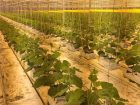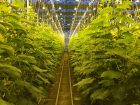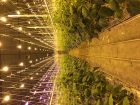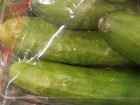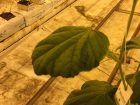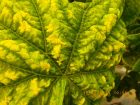
Features
Lighting
Structures & Equipment
Supplemental Lighting Challenges, by Dr. Mohyuddin Mirza
If you’re growing vegetables in winter or under low light conditions, artificial lights are a must. Without them, you’ll never get up to PAR in bringing the crop to harvest.
January 18, 2017 By Dr. Mohyuddin Mirza
February 2017 – Growing vegetables in winter using supplemental lights is on the increase in Canada. Alberta currently has over 30 acres under lights for winter production of cucumbers and some tomatoes. Growers are experimenting with peppers as well.
A one-acre range of tomatoes has been built with LED lights and a crop is being grown. This is the first project of its kind in the province, although a few growers have been experimenting with LED inter-lighting. Some great research work is being conducted at the Greenhouse Research and Development Complex, Crop Diversification Centre South in Brooks, Alta.
The challenges of using supplemental light were highlighted when the weather was cloudy for several days in December. This is when prices are good and you want excellent quality production to supply the market.
The reason we refer to artificial lights as “supplemental” lights is that these units supplement the natural sunlight. Without sunlight, these lights don’t provide sufficient photosynthetically active radiation (PAR). For example in November and December 2016, the light intensity measured by sensors ranged from 47 joules to 153 joules and this was over a period of 10 days. These light sensors are located outside the greenhouse. The light coming inside the greenhouse is further reduced.
The PAR light provided by artificial lights is truly supplemental. Photo A shows the distance from HPS lights to young plants. The PAR was around 50-70 micromoles/sq.m/second. These seedlings were growing adequately due to the supply of sunlight in October.
Photo B shows where plants are fully grown and situated closer to the supplemental lights. The light measured at the top of the plants was close to 150 micromoles/sq.m/second. You can see LED top lights on the left side of the picture.
Photo C shows how more light is available at the top and how lower leaves are shaded.
The end result is that if natural light is low, the plant is not making enough food or assimilates to feed or fill all the fruit that is set. The first sign is that fruit abortion occurs. The point I am making is that if natural light is less than 600 joules/sq.cm, then it will be considered a low light situation.
Besides fruit abortion the fruit quality will also be affected and reduced. The fruit is hanging on too long to mature. Shelf life is very poor in such cucumbers. In Photo D you can see loss of colour, soft blossom ends and with a slight touch the skin can sink.
As mentioned earlier, if light levels are low, the plant cannot manufacture enough assimilates to satisfy the demands of the roots, shoots, leaves and fruits. The plant will try to make more leaves and temporary root decay can occur. A warning sign is that the pH of the growing medium will start going down. I have seen pH values below 5.0 and that can cause root damage.
Here are some strategies growers can use to keep plants growing and producing:
- Manage temperatures daily based on leaf temperature. Use a hand-held infrared thermometer to check the leaf temperature. – On cloudy days, the 24-hour average temperature can be reduced to around 20.5 C in the case of cucumbers. You can reduce day temperature to achieve this.
- Adjust your watering accordingly. – If light levels are low, the plant is not transpiring much and so water needs are reduced. Cut down on drain percentage, otherwise a waterlogged situation can cause pythium.
- Electrical conductivity (E.C.) in the feed can be increased to over 3 mmhos and the leach can be maintained around 4.0 mmhos.
- Increase your carbon dioxide levels to around 800-900 ppm.If you are using carbon dioxide from boilers, be sure to check the nitrous oxide and ethylene levels inside the greenhouse.
During cloudy days and cold weather, there is minimum venting and the levels of these pollutants can go to toxic levels. The first symptoms appear on leaves with them being very dark green, puckered and smaller sized. The leaves start turning yellow very early. Note the effects in Photo E (short-term exposure) and Photo F (long-term chronic exposure).
Plants under such conditions are very susceptible to insects like thrips, whitefly and aphids. Watch the plants carefully and manage accordingly.
Powdery mildew can become very aggressive under cloudy conditions, so plan to control this fungus early.
Avoid climate fluctuations as this could result in edema – the cells burst open due to a rapid drop in temperature when lights are turned off.
Dr. Mohyuddin Mirza is an industry consultant, drmirzaconsultants@gmail.com.
Print this page
